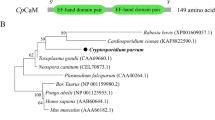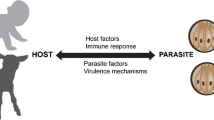Abstract
The parasite Cryptosporidium parvum Tyzzer 1912 destroys parts of the intestinal brush border membrane which is important for the uptake of nutrients like glucose. In this study, glucose transport mechanisms of the host cells (IPEC-J2 cells) infected by C. parvum were investigated. The mRNA expression levels of glucose transporters (GLUT) 1 and 2 and Na+-coupled glucose transporter (SGLT) 1 were compared in infected and uninfected cells over an infection time of 24–96 h by RT-qPCR. Furthermore, the protein expression of SGLT 1 and GLUT 2 was quantified in western blot studies. While the protein expression of SGLT 1 was not altered in infected cells, mRNA expression of SGLT 1 and GLUT 1 was significantly increased 24 h p. i. and decreased 96 h p. i. The mRNA expression of GLUT 2 was significantly decreased 24 h, 72 h, and 96 h p. i. and also correlated significantly with the infection dose at 72 h p. i. In contrast to that, the protein expression of GLUT 2 was significantly increased 48 h p. i., associated with a significantly higher intracellular glucose level in infected cells compared with control cells at that time point of infection. This points to an adaptation of the host cells’ glucose uptake taking place in the acute phase of the infection. A better understanding of these molecular mechanisms following a C. parvum infection may probably lead to an improvement of therapy strategies in the future.







Similar content being viewed by others
References
Argenzio RA, Liacos JA, Levy ML, Meuten DJ, Lecce JG, Powell DW (1990) Villous atrophy, crypt hyperplasia, cellular infiltration, and impaired glucose-Na absorption in enteric cryptosporidiosis of pigs. Gastroenterology 98:1129–1140
Berschneider HM (1989) Development of normal cultured small intestinal epithelial cell lines which transport Na and Cl (Abstract). Gasteroenterology 96:A41
Boyer S, Sharp PA, Debnam ES, Baldwin SA, Srai SKS (1996) Streptozotocin diabetes and the expression of GLUT1 at the brush border and basolateral membranes of intestinal enterocytes. FEBS Lett 396:218–222
Bürzle M, Hediger MA (2012) Functional and physiological role of vitamin C transporters. Curr Top Membr 70:357–375. https://doi.org/10.1016/B978-0-12-394316-3.00011-9
Capet C, Kapel N, Huneau JF, Magne D, Laikuen R, Tricottet V, Benhamou Y, Tomé D, Gobert JG (1999) Cryptosporidium parvum infection in suckling rats: impairment of mucosal permeability and Na(+)-glucose cotransport. Exp Parasitol 91:119–125
Chen XM, O’Hara SP, Huang BQ, Splinter PL, Nelson JB, LaRusso NF (2005) Localized glucose and water influx facilitates Cryptosporidium parvum cellular invasion by means of modulation of host-cell membrane protrusion. Proc Natl Acad Sci U S A. 102:6338–6343
Chen L, Tuo B, Dong H (2016) Regulation of intestinal glucose absorption by ion channels and transporters. Nutrients 8:43. https://doi.org/10.3390/nu8010043
Das S, Jayaratne R, Barrett KE (2018) The Role of Ion Transporters in the Pathophysiology of Infectious Diarrhea. Cellular and Molecular Gastroenterology and Hepatology 6 (1):33–45
Delling C, Lendner M, Müller U, Daugschies A (2017) Improvement of in vitro evaluation of chemical disinfectants for efficacy on Cryptosporidium parvum oocysts. Vet Parasitol 245:5–13. https://doi.org/10.1016/j.vetpar.2017.07.018
Dengler F, Rackwitz R, Pfannkuche H, Gäbel G (2017) Glucose transport across lagomorph jejunum epithelium is modulated by AMP-activated protein kinase under hypoxia. J Appl Physiol (1985) 1236:1487–1500. https://doi.org/10.1152/japplphysiol.00436.2017
Dengler F, Rackwitz R, Pfannkuche H, Gäbel G (2018) Coping with hypoxia: adaptation of glucose transport mechanisms across equine jejunum epithelium. JEVS 69:1–10
Dominguez JH, Song B, Maianu L, Garvey WT, Qulali M (1994) Gene expression of epithelial glucose transporters: the role of diabetes mellitus. J Am Soc Nephrol. 5:29–36
Dresely I, Daugschies A, Lendner M (2015) Establishment of a germ carrier assay to assess disinfectant efficacy against oocysts of coccidian parasites. Parasitol Res 114:273–281
Drinkall E, Wass MJ, Coffey TJ, Flynn RJ (2017) A rapid IL-17 response to Cryptosporidium parvum in the bovine intestine. Vet Immunol Immunopathol 191:1–4
Ferguson SH, Foster DM, Sherry B, Magness ST, Nielsen DM, Gookin JL (2019) Interferon-λ3 promotes epithelial defense and barrier function against Cryptosporidium parvum infection. Cell Mol Gastroenterol Hepatol 8:1–20. https://doi.org/10.1016/j.jcmgh.2019.02.007
Foster DM, Stauffer SH, Stone MR, Gookin JL (2012) Proteasome inhibition of pathologic shedding of enterocytes to defend barrier function requires X-linked inhibitor of apoptosis protein and nuclear factor κB. Gastroenterology 143:133–144. https://doi.org/10.1053/j.gastro.2012.03.030
Göhring F, Möller-Holtkamp P, Daugschies A, Lendner M (2014) Untersuchungen zur Häufigkeit von Cryptosporidium parvum bei Durchfallkälbern und der Einfluss von Koinfektionen auf das Krankheitsgeschehen. Tierärztl Umschau 69:000–000
Huang BQ, Chen XM, LaRusso NF (2004) Cryptosporidium parvum attachment to and internalization by human biliary epithelia in vitro: a morphologic study. J Parasitol 90:212–221
Kellett GL, Brot-Laroche E, Mace OJ, Leturque A (2008) Sugar absorption in the intestine: the role of GLUT2. Annu Rev Nutr 28:35–54. https://doi.org/10.1146/annurev.nutr.28.061807.155518
Kotloff KL, Nataro JP, Blackwelder WC, Nasrin D, Farag TH, Panchalingam S, Wu Y, Sow SO, Sur D, Breiman RF, Faruque AS, Zaidi AK, Saha D, Alonso PL, Tamboura B, Sanogo D, Onwuchekwa U, Manna B, Ramamurthy T, Kanungo S, Ochieng JB, Omore R, Oundo JO, Hossain A, Das SK, Ahmed S, Qureshi S, Quadri F, Adegbola RA, Antonio M, Hossain MJ, Akinsola A, Mandomando I, Nhampossa T, Acácio S, Biswas K, O’Reilly CE, Mintz ED, Berkeley LY, Muhsen K, Sommerfelt H, Robins-Browne RM, Levine MM (2013) Burden and aetiology of diarrhoeal disease in infants and young children in developing countries (the Global Enteric Multicenter Study, GEMS): a prospective, case-control study. Lancet 382:209–222
Krimi RB, Letteron P, Chedid P, Nazaret C, Ducroc R, Marie JC (2009) Resistin-like molecule-beta inhibits SGLT-1 activity and enhances GLUT2-dependent jejunal glucose transport. Diabetes 58:2032–2038. https://doi.org/10.2337/db08-1786
Lehmann A, Hornby PJ (2016) Intestinal SGLT1 in metabolic health and disease. Am J Physiol Gastrointest Liver Physiol 310:887–898. https://doi.org/10.1152/ajpgi.00068.2016
Leitch GJ, He Q (2012) Cryptosporidiosis-an overview. J Biomed Res 25:1–16
Lendner M, Daugschies (2014) Cryptosporidium infections: molecular advances. Parasitology 141:1511–1532. https://doi.org/10.1017/S0031182014000237
Lendner M, Etzold M, Daugschies A (2011) Kryptosporidiose – ein Update. Berl Münch Tierärztl Wochenschr 124:10–21
Liu J, Deng M, Lancto CA, Abrahamsen MS, Rutherford MS, Enomoto S (2009) Biphasic modulation of apoptotic pathways in Cryptosporidium parvum-infected human intestinal epithelial cells. Infect Immun 77:837–849. https://doi.org/10.1128/IAI.00955-08
Long W, Cheeseman CI (2015) Cell Health Cytoskeleton 7:167-83
Metheni M, Lombès A, Bouillaud F, Batteux F, Langsley G (2015) HIF-1α induction, proliferation and glycolysis of Theileria-infected leucocytes. Cell Microbiol 17:467–472
Mirhashemi ME, Noubary F, Chapman-Bonofiglio S, Tzipori S, Huggins GS, Widmer G (2018) Transcriptome analysis of pig intestinal cell monolayers infected with Cryptosporidium parvum asexual stages. Parasit Vectors 11:176. https://doi.org/10.1186/s13071-018-2754-3
Moore R, Tzipori S, Griffiths JK, Johnson K, De Montigny L, Lomakina I (1995) Temporal changes in permeability and structure of piglet ileum after site-specific infection by Cryptosporidium parvum. Gastroenterology 108:1030–1039
Mueckler M, Thorens B (2013) The SLC2 (GLUT) family of membrane transporters. Mol Aspects Med 34:121–138. https://doi.org/10.1016/j.mam.2012.07.001
Najdrowski M, Joachim A, Daugschies A (2007) An improved in vitro infection model for viability testing of Cryptosporidium parvum oocysts. Vet Parasitol 150:150–154
Notari L, Riera DC, Sun R, Bohl JA, McLean LP, Madden KB, van Rooijen N, Vanuytsel T, Urban JF Jr, Zhao A, Shea-Donohue T (2014) Role of macrophages in the altered epithelial function during a type 2 immune response induced by enteric nematode infection. PLoS One 9:e84763. https://doi.org/10.1371/journal.pone.0084763 eCollection 2014
O’Hara SP, Gajdos GB, Trussoni CE, Splinter PL, LaRusso NF (2010) Cholangiocyte myosin IIB is required for localized aggregation of sodium glucose cotransporter 1 to sites of Cryptosporidium parvum cellular invasion and facilitates parasite internalization. Infect Immun 78:2927–2936. https://doi.org/10.1128/IAI.00077-10
O’Hara SP, Chen X-M (2011) The cell biology of cryptosporidium infection. Microbes and Infection 13 (8-9):721–730
Pfaffl MW, Horgan GW, Dempfle L (2002) Relative expression software tool (REST) for group-wise comparison and statistical analysis of relative expression results in real-time PCR. Nucleic Acids Res 30(9):e36
Platts-Mills JA, Babji S, Bodhidatta L, Gratz J, Haque R, Havt A, McCormick BJ, McGrath M, Olortegui MP, Samie A, Shakoor S, Mondal D, Lima IF, Hariraju D, Rayamajhi BB, Qureshi S, Kabir F, Yori PP, Mufamadi B, Amour C, Carreon JD, Richard SA, Lang D, Bessong P, Mduma E, Ahmed T, Lima AA, Mason CJ, Zaidi AK, Bhutta ZA, Kosek M, Guerrant RL, Gottlieb M, Miller M, Kang G, Houpt ER (2015) MAL-ED Network Investigators. Pathogen – specific burdens of community diarrhoea in developing countries: a multisite birth cohort study (MAL-ED). Lancet Glob Health 3:e564–e575
Rider SD, Zhu G (2010) Cryptosporidium: Genomic and biochemical features. Experimental Parasitology 124 (1):2–9
Sasahara T, Maruyama H, Aoki M, Kikuno R, Sekiguchi T, Takahashi A, Satoh Y, Kitasato H, Takayama Y, Inoue M (2003) Apoptosis of intestinal crypt epithelium after Cryptosporidium parvum infection. J Infect Chemother. 9:278–281
Schierack P, Nordhoff M, Pollmann M, Weyrauch KD, Amasheh S, Lodemann U, Jores J, Tachu B, Kleta S, Blikslager A, Tedin K, Wieler LH (2006) Characterization of a porcine intestinal epithelial cell line for in vitro studies of microbial pathogenesis in swine. Histochem Cell Biol 125:293–305
Sekikawa S, Kawai Y, Fujiwara A, Takeda K, Tegoshi T, Uchikawa R, Yamada M, Arizono N (2003) Alterations in hexose, amino acid and peptide transporter expression in intestinal epithelial cells during Nippostrongylus brasiliensis infection in the rat. Int J Parasitol 33 (12):1419–1426
Semenza GL (2011) Regulation of metabolism by hypoxia-inducible factor 1. Cold Spring Harb Symp Quant Biol 76:347–353. https://doi.org/10.1101/sqb.2011.76.010678
Shepherd EJ, Helliwell PA, Mace OJ, Morgan EL, Patel N, Kellett GL (2004) Stress and glucocorticoid inhibit apical GLUT2-trafficking and intestinal glucose absorption in rat small intestine. J Physiol 560 (1):281–290
Spear W, Chan D, Coppens I, Johnson RS, Giaccia A, Blader IJ (2006) The host cell transcription factor hypoxia-inducible factor 1 is required for Toxoplasma gondii growth and survival at physiological oxygen levels. Cell Microbiol 8:339–352
Steinhoff-Wagner J, Zitnan R, Schönhusen U, Pfannkuche H, Hudakova M, Metges CC (2014) Diet effects on glucose absorption in the small intestine of neonatal calves: importance of intestinal mucosal growth, lactase activity, and glucose transporters. J Dairy Sci. https://doi.org/10.3168/jds.2014-8391
Tyzzer EE (1912) Cryptosporidium parvum (sp. nov.), a coccidium found in the small intestine of the common mouse. Arch Protistenkd 26:394–412
Vandesompele J, De Preter K, Pattyn F, Poppe B, Van Roy N, De Paepe A, Speleman F (2002) Accurate normalization of real-time quantitative RT-PCR data by geometric averaging of multiple internal control genes. Genome Biol 3:RESEARCH0034
Wiley M, Sweeney KR, Chan DA, Brown KM, McMurtrey C, Howard EW, Giaccia AJ, Blader IJ (2010) Toxoplasma gondii activates hypoxia-inducible factor (HIF) by stabilizing the HIF-1α subunit via type I activing-like receptor kinase receptor signaling. J Biol Chem 285:26852–26860
Wright EM, Martín MG, Turk E (2003) Intestinal absorption in health and disease--sugars. Best Pract Res Clin Gastroenterol 17:943–956
Yang YL, Buck GA, Widmer G (2010) Cell sorting-assisted microarray profiling of host cell response to Cryptosporidium parvum infection. Infect Immun 78:1040–1048. https://doi.org/10.1128/IAI.01009-09
Yu Y, Zhang H, Guo F, Sun M, Zhu G (2014) A unique hexokinase in Cryptosporidium parvum, an apicomplexan pathogen lacking the Krebs cycle and oxidative phosphorylation. Protist 165(5):701–714. https://doi.org/10.1016/j.protis.2014.08.002
Acknowledgments
The authors want to thank S. Gawlowska and I. Urbansky for excellent technical assistance.
Funding
This study was funded by a starting grant of the Faculty of Veterinary Medicine, University of Leipzig as well as the “Freundeskreis Tiermedizin der Veterinärmedizinischen Fakultät Leipzig e.V.” The Leica TCS SP8 laser scanning microscope as well as the graphic work station equipped with IMARIS 9.3 was provided by the BioImaging Core Facility, University of Leipzig.
Author information
Authors and Affiliations
Corresponding author
Ethics declarations
Conflict of interest statement
The authors declare that they have no conflict of interest.
Statement of informed consent
All applicable international, national, and/or institutional guidelines for the care and use of the animals were followed. All procedures concerning the animals, which were used for the passage of the parasite, were performed in accordance with the ethical standards of the institution (Regional Council of Saxony following German law: TierSchG, TieSchVersV; permit number: A 06/19).
Additional information
Section Editor: Lihua Xiao
Publisher’s note
Springer Nature remains neutral with regard to jurisdictional claims in published maps and institutional affiliations.
Rights and permissions
About this article
Cite this article
Delling, C., Daugschies, A., Bangoura, B. et al. Cryptosporidium parvum alters glucose transport mechanisms in infected enterocytes. Parasitol Res 118, 3429–3441 (2019). https://doi.org/10.1007/s00436-019-06471-y
Received:
Accepted:
Published:
Issue Date:
DOI: https://doi.org/10.1007/s00436-019-06471-y




